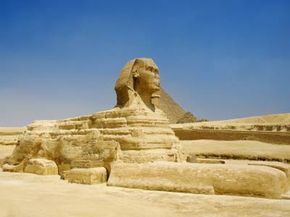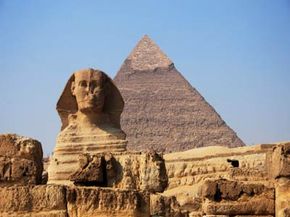After seizing the reins of power in France and storming through Italy, Napoleon set his sights on a new continent: Africa. French troops invaded the shores at Alexandria and headed into Cairo in the summer of 1798. But intense heat and unwelcoming locals didn't make for a pleasant stay. Soldiers were restless to return home and complained of incessant boredom. To pass the time, some scaled the nearby pyramids at Giza. From that vantage point, they would've had a bird's-eye view of the head of the Great Sphinx, which at that time was buried to its neck in sand.
Those same listless French soldiers have shouldered the blame for the Sphinx's missing nose. Some inventive historians imagined the men treating the pale limestone face as an oversized target for artillery practice. But sketches by artist and architect Frederick Lewis Norden from 1737 -- more than 50 years before Napoleon's arrival -- show the Sphinx without a nose, exonerating the French soldiers [source: Sweeney]. Furthermore, the nose had probably been missing for a handful of centuries [source: Dwyer].
Advertisement
The disappearance of the Sphinx's nose is just one of many puzzles surrounding the massive statue. The ghostly stone head costumed with the traditional nemes headdress of the pharaohs rises 65 feet (20 meters) above the ground. It rests atop the body and haunches of a lion whose limbs stretch out along 187 feet (57 meters) near the entrance of the Giza Necropolis. The necropolis, consisting of the Great Sphinx, Great Pyramids and minor burial chambers and temples, was constructed by pharaohs Khufu, Khafre and Menkaure from the Old Kingdom's Fourth Dynasty (2560 to 2450 B.C.).
Ironically, the identity of that somber, worn face is one of the least debated aspects of the Great Sphinx. Mainstream Egyptologists agree that it belongs to pharaoh Khafre (also known as Chephren). More than 4,500 years ago in peak condition, the Great Sphinx, painted and adorned with the long, braided beard characteristic of the divinities and the deceased, bore a close physical resemblance to Khafre. The statue also is constructed from the same bedrock as Khafre's burial pyramid and nearly perfectly aligned with it [source: National Geographic].
But the riddle of the Great Sphinx of Giza is far from solved -- at least according to some. Since its modern excavation by Emile Baraize beginning in 1926, it seems that Khafre's monument has raised more questions than it has answered.
Advertisement

